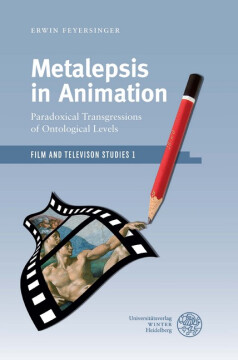
BUCH
Metalepsis in Animation
Paradoxical Transgressions of Ontological Levels
Film and Television Studies, Bd. 1
2017
Zusätzliche Informationen
Bibliografische Daten
Abstract
The narratological term metalepsis describes a seemingly paradoxical transgression of narrative or ontological levels that are perceived as mutually exclusive. While metalepsis can be found across a variety of media, it is a specifically important device in animated films and television Series. Prominent examples are the hand of the animator reaching into the diegesis of her or his creations or characters escaping into the world of their creators. 'Metalepsis in Animation: Paradoxical Transgressions of Ontological Levels' explores various functions and uses of metalepses throughout the history of animation and develops models of mental processes that govern their cognitive production and reception.
Inhaltsverzeichnis
| Zwischenüberschrift | Seite | Aktion | Preis |
|---|---|---|---|
| Cover | C | ||
| Title Page | 3 | ||
| Imprint | 4 | ||
| Table of Contents | 5 | ||
| Acknowledgments | 7 | ||
| 1 Introduction | 9 | ||
| 2 The Term and Concept Metalepsis | 11 | ||
| 3 Metalepsis in Animation | 19 | ||
| 3.1 Extradiegetic Intervention in the Diegesis | 21 | ||
| 3.2 Characters Escape to a Framing Extradiegesis | 23 | ||
| 3.3 Characters Alter Their Own Worlds | 24 | ||
| 3.4 From Diegesis to Metadiegesis: Entering Images | 25 | ||
| 3.5 Permeating the Screen: The Extrafilmic Frame | 26 | ||
| 3.6 Ontologically Distinct Elements within One Diegesis | 28 | ||
| 3.7 Naturalized, Violent, and Continuous Metalepses | 29 | ||
| 4 Metalepsis, Metaization, and the Renaissance of Animation | 33 | ||
| 4.1 Metareferentiality and the Current Boom of Animation | 33 | ||
| 4.2 Three Metareferential Catalysts for the Boom of Animation: ‚Who Framed Roger Rabbit‘, MTV, and ‚The Simpsons‘ | 34 | ||
| 4.3 Historicizing Meta-Metareference: A New Level of Metaization | 39 | ||
| 4.3.1 The Representation of Prototechnologies in ‚Tim Tom‘ | 40 | ||
| 4.3.2 The Representation of Precursory Techniques in ‚Tim Tom‘ | 42 | ||
| 4.3.3 The Representation of Older Recording Media in ‚Tim Tom‘ | 43 | ||
| 4.4 Conclusion | 45 | ||
| 5 Metalepsis and TV Crossovers | 47 | ||
| 5.1 Configurations of Metalepses and Metaleptic Effects in Crossovers | 49 | ||
| 5.1.1 Metaleptic Spin-offs | 50 | ||
| 5.1.2 Inconsistent Fictionality Status | 51 | ||
| 5.1.3 Strange Loops | 53 | ||
| 5.1.4 Transgressing Promotional Paratexts | 54 | ||
| 5.1.5 Naturalized Metaleptic “Crossovers” | 56 | ||
| 5.2 Theorizing Crossovers and Metalepses | 57 | ||
| 5.2.1 Dynamic World Construction: Diegetization | 58 | ||
| 5.2.2 Static Concepts of Worlds | 61 | ||
| 5.2.3 Basic Structures of Metalepsis and Crossover | 62 | ||
| 5.2.4 Potential Configurations of Transgressions | 65 | ||
| 5.2.5 Modes of Representation and the Identity of a Character | 70 | ||
| 5.3 Conclusion | 74 | ||
| 6 The Theory of Conceptual Blending | 77 | ||
| 7 Metalepsis and the Integrity of a Character | 79 | ||
| 7.1 Duck Amuck as Object of Study | 80 | ||
| 7.2 The Identity of a Character Based on Intrafilmic Blends | 81 | ||
| 7.3 Three Perspectives on Daffy’s Evolution | 85 | ||
| 7.4 Daffy Struggling Through Film Genres | 88 | ||
| 7.5 Daffy Makes a Movie | 92 | ||
| 7.6 Daffy as Studio Star | 96 | ||
| 7.7 Conclusion | 100 | ||
| 8 Metamorphoses | 103 | ||
| 8.1 Animation’s Affinity with Metamorphoses | 104 | ||
| 8.2 Character-Based Metamorphosis in General | 105 | ||
| 8.3 Character-Based Metamorphosis in Animation | 106 | ||
| 8.3.1 Anthropomorphism and Conceptual Blending | 108 | ||
| 8.3.2 Metamorphic Hyperbodies | 113 | ||
| 8.3.3 Metamorphosis of Character and Setting | 115 | ||
| 8.4 Conclusion | 123 | ||
| 9 Metalepsis and Blending Theory | 125 | ||
| 9.1 Blending and Metalepsis: Theoretical Overlaps | 125 | ||
| 9.2 Metalepsis and Blending in Literature | 128 | ||
| 9.3 Metalepsis and Blending in Film | 136 | ||
| 9.4 The Conceptual Blending of Metalepsis: A Generic Model | 142 | ||
| 9.5 Conclusion | 144 | ||
| 10 Final Thoughts | 145 | ||
| 11 Bibliography | 149 | ||
| Backcover | 164 |


 Publishing Platform by CloudPublish
Publishing Platform by CloudPublish